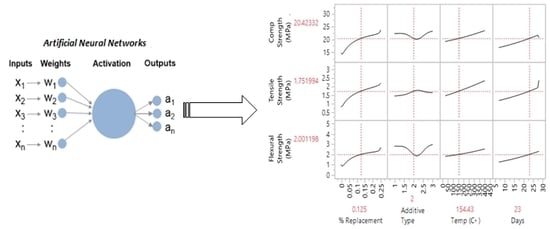Analysis of Mechanical Properties of Self Compacted Concrete by Partial Replacement of Cement with Industrial Wastes under Elevated Temperature
Abstract
:1. Introduction
2. Materials and Methods
2.1. Major Ingredients
2.1.1. Silica Fume
2.1.2. Ground Granulated Blast Furnace Slag (GGBFS)
2.1.3. Marble Powder (MP)
2.1.4. Superplasticizer
2.2. Concrete Preparation and Testing
2.2.1. Development of Concrete
2.2.2. Properties of Fresh Concrete
2.2.3. Properties of Hardened Concrete
2.2.4. Temperature Treatment
3. Results and Discussion
3.1. Compressive Strength
3.2. Indirect Tensile Strength
3.3. Flexural Strength
3.4. Strength Prediction and Relationship Analysis
3.4.1. Model Parameter
3.4.2. Prediction Profiler
3.4.3. Interaction Profiles
3.4.4. Variable Importance
4. Conclusions
Acknowledgments
Author Contributions
Conflicts of Interest
References
- Duval, R.; Kadri, E. Influence of silica fume on the workability and the compressive strength of high-performance concretes. Cem. Concr. Res. 1998, 28, 533–547. [Google Scholar] [CrossRef]
- Zain, M.F.M.; Safiuddin, M.; Mahmud, H. Development of high performance concrete using silica fume at relatively high water–binder ratios. Cem. Concr. Res. 2000, 30, 1501–1505. [Google Scholar] [CrossRef]
- Aldred, J.M.; Holland, T.C.; Morgan, D.R.; Roy, D.M.; Bury, M.A.; Hooton, R.D.; Olek, J.; Scali, M.J.; Detwiler, R.J.; Jaber, T.M. Guide for the Use of Silica Fume in Concrete; ACI–American Concrete Institute–Committee: Farmington Hills, MI, USA, 2006; Volume 234. [Google Scholar]
- Benzaid, M.; Benmarce, A. Behaviour of self compacting concrete mixed with different additions at high-temperature. J. Meter. Environ. Sci. 2017, 8, 3081–3092. [Google Scholar]
- Bharath, E.; Shishaila, J.M.; Prakash, P.; Puttiah, P.K.W. Effect of partial replacement of cement in self-compacting concrete by fly ash and metakaolin. Int. J. Eng. Res. Technol. 2015, 4, 339–346. [Google Scholar] [CrossRef]
- Bakhtiyari, S.; Allahverdi, A.; Rais-Ghasemi, M.; Zarrabi, B.; Parhizkar, T. Self-compacting concrete containing different powders at elevated temperatures–mechanical properties and changes in the phase composition of the paste. Thermochim. Acta 2011, 514, 74–81. [Google Scholar] [CrossRef]
- Gesoğlu, M.; Güneyisi, E.; Kocabağ, M.E.; Bayram, V.; Mermerdaş, K. Fresh and hardened characteristics of self compacting concretes made with combined use of marble powder, limestone filler, and fly ash. Constr. Build. Mater. 2012, 37, 160–170. [Google Scholar] [CrossRef]
- Mohamed, H.A. Effect of fly ash and silica fume on compressive strength of self-compacting concrete under different curing conditions. Ain Shams Eng. J. 2011, 2, 79–86. [Google Scholar] [CrossRef]
- Sadek, D.M.; El-Attar, M.M.; Ali, H.A. Reusing of marble and granite powders in self-compacting concrete for sustainable development. J. Clean. Prod. 2016, 121, 19–32. [Google Scholar] [CrossRef]
- Arefi, M.R.; Rezaei-Zarchi, S. Synthesis of zinc oxide nanoparticles and their effect on the compressive strength and setting time of self-compacted concrete paste as cementitious composites. Int. J. Mol. Sci. 2012, 13, 4340–4350. [Google Scholar] [CrossRef] [PubMed]
- Siddique, R.; Aggarwal, P.; Aggarwal, Y. Prediction of compressive strength of self-compacting concrete containing bottom ash using artificial neural networks. Adv. Eng. Softw. 2011, 42, 780–786. [Google Scholar] [CrossRef]
- Tao, J.; Yuan, Y.; Taerwe, L. Compressive strength of self-compacting concrete during high-temperature exposure. J. Mater. Civ. Eng. 2010, 22, 1005–1011. [Google Scholar] [CrossRef]
- Turk, K.; Karatas, M.; Gonen, T. Effect of fly ash and silica fume on compressive strength, sorptivity and carbonation of SCC. KSCE J. Civ. Eng. 2013, 17, 202–209. [Google Scholar] [CrossRef]
- Asteris, P.; Kolovos, K.; Douvika, M.; Roinos, K. Prediction of self-compacting concrete strength using artificial neural networks. Eur. J. Environ. Civ. Eng. 2016, 20, s102–s122. [Google Scholar] [CrossRef]
- Douma, O.B.; Boukhatem, B.; Ghrici, M.; Tagnit-Hamou, A. Prediction of properties of self-compacting concrete containing fly ash using artificial neural network. Neural Comput. Appl. 2017, 28, 707–718. [Google Scholar] [CrossRef]
- Nehdi, M.; El Chabib, H.; El Naggar, M.H. Predicting performance of self-compacting concrete mixtures using artificial neural networks. Mater. J. 2001, 98, 394–401. [Google Scholar]
- Zi-ruo, Y.; Ming-zhe, A.; Ming-bo, Z. Predicting the compressive strength of self compacting concrete using artificial neural network. In Proceedings of the Second International Symposium on Design, Perormance and Use of Self Consolidating Concrete SCC, Beijing, China, 5–7 June 2009; pp. 452–459. [Google Scholar]
- Dinakar, P.; Sethy, K.P.; Sahoo, U.C. Design of self-compacting concrete with ground granulated blast furnace slag. Mater. Des. 2013, 43, 161–169. [Google Scholar] [CrossRef]
- Hassan, A.A.; Lachemi, M.; Hossain, K.M. Effect of metakaolin and silica fume on the durability of self-consolidating concrete. Cem. Concr. Compos. 2012, 34, 801–807. [Google Scholar] [CrossRef]
- Melo, K.A.; Carneiro, A.M. Effect of metakaolin’s finesses and content in self-consolidating concrete. Constr. Build. Mater. 2010, 24, 1529–1535. [Google Scholar] [CrossRef]
- Su, N.; Hsu, K.-C.; Chai, H.-W. A simple mix design method for self-compacting concrete. Cem. Concr. Res. 2001, 31, 1799–1807. [Google Scholar] [CrossRef]
- Kristulovic, P.; Kamenic, N.; Popovic, K. A new approach in evaluation of filler effect in cement. Cem. Concr. Res. 1994, 24, 721–727. [Google Scholar] [CrossRef]
- Yılmaz, B.; Ediz, N. The use of raw and calcined diatomite in cement production. Cem. Concr. Compos. 2008, 30, 202–211. [Google Scholar] [CrossRef]
- Ozawa, K.; Sakata, N.; Okamura, H. Evaluation of self-compactability of fresh concrete using the funnel test. Doboku Gakkai Ronbunshu 1994, 1994, 61–70. [Google Scholar] [CrossRef]
- Yaman, M.A.; Elaty, M.A.; Taman, M. Predicting the ingredients of self compacting concrete using artificial neural network. Alexandria Eng. J. 2017, 56, 523–532. [Google Scholar] [CrossRef]
- Neville, A.; Brooks, J. Concrete Technology; Longman Scientific and Technical: London, UK, 2010. [Google Scholar]
- Kodur, V.; Sultan, M. Effect of temperature on thermal properties of high-strength concrete. J. Mater. Civ. Eng. 2003, 15, 101–107. [Google Scholar] [CrossRef]
- Saad, M.; Abo-El-Enein, S.; Hanna, G.; Kotkata, M. Effect of temperature on physical and mechanical properties of concrete containing silica fume. Cem. Concr. Res. 1996, 26, 669–675. [Google Scholar] [CrossRef]
- Phan, L.T.; Lawson, J.R.; Davis, F.L. Effects of elevated temperature exposure on heating characteristics, spalling, and residual properties of high performance concrete. Mater. Struct. 2001, 34, 83–91. [Google Scholar] [CrossRef]
- Alyamaç, K.E.; Ince, R. A preliminary concrete mix design for scc with marble powders. Constr. Build. Mater. 2009, 23, 1201–1210. [Google Scholar] [CrossRef]
- Topcu, I.B.; Bilir, T.; Uygunoğlu, T. Effect of waste marble dust content as filler on properties of self-compacting concrete. Constr. Build. Mater. 2009, 23, 1947–1953. [Google Scholar] [CrossRef]
- Corinaldesi, V.; Moriconi, G. The influence of mineral additions on the rheology of self-compacting concrete. Spec. Publ. 2003, 217, 227–240. [Google Scholar]
- Celik, M.; Sabah, E. Marble deposits and the impact of marble waste on environmental pollution geological and technical characterization of iscehisar (Afyon–Turkey). J. Environ. Manag. 2008, 87, 6–116. [Google Scholar]
- Türker, P.; Erdogan, B.; Erdogdu, K. Influence of marble powder on microstructure and hydration of cements. Cem. Concr. World J. TÇMB (Turkey) 2002, 7, 38–89. [Google Scholar]
- Türkmen, İ. Influence of different curing conditions on the physical and mechanical properties of concretes with admixtures of silica fume and blast furnace slag. Mater. Lett. 2003, 57, 4560–4569. [Google Scholar] [CrossRef]
- Türkmen, İ.; Kantarcı, A. Effects of expanded perlite aggregate and different curing conditions on the physical and mechanical properties of self-compacting concrete. Build. Environ. 2007, 42, 2378–2383. [Google Scholar] [CrossRef]
- Unal, O.; Uygunoglu, T. Investigation of mechanical properties of waste marble dusty concrete which under the effect of freeze and thaw. In Proceedings of the Turkey 4th Marble Symposium, Afyon, Turkey, 18–19 December 2003; pp. 147–157. [Google Scholar]
- Valls, S.; Yagüe, A.; Vázquez, E.; Mariscal, C. Physical and mechanical properties of concrete with added dry sludge from a sewage treatment plant. Cem. Concr. Res. 2004, 34, 2203–2208. [Google Scholar] [CrossRef]
- Shetty, M. Concrete Technology Theory & Practice; CHAND & Company: New Delh, India, 2005. [Google Scholar]
- ASTM International. Standard Test Method for Electrical Indication of Concrete’s Ability to Resist Chloride Ion Penetration; C1202-97, Annual Book of ASTM Standards; ASTM International: West Conshohocken, PA, USA, 1997; Volume 4, pp. 639–644. [Google Scholar]
- Pfeifer, D.W.; McDonald, D.B.; Krauss, P.D. The rapid chloride permeability test and its correlation to the 90-day chloride ponding test. PCI J. 1994, 39, 38–47. [Google Scholar] [CrossRef]
- Ganesh, S. Mechanical and durability properties of self compacting concrete. Int. J. Eng. Trends Technol. 2017, 48, 193–199. [Google Scholar] [CrossRef]
- Shigidi, A.; Garcia, L.A. Parameter estimation in groundwater hydrology using artificial neural networks. J. Comput. Civ. Eng. 2003, 17, 281–289. [Google Scholar] [CrossRef]
- Rogers, J.L. Simulating structural analysis with neural network. J. Comput. Civ. Eng. 1994, 8, 252–265. [Google Scholar] [CrossRef]
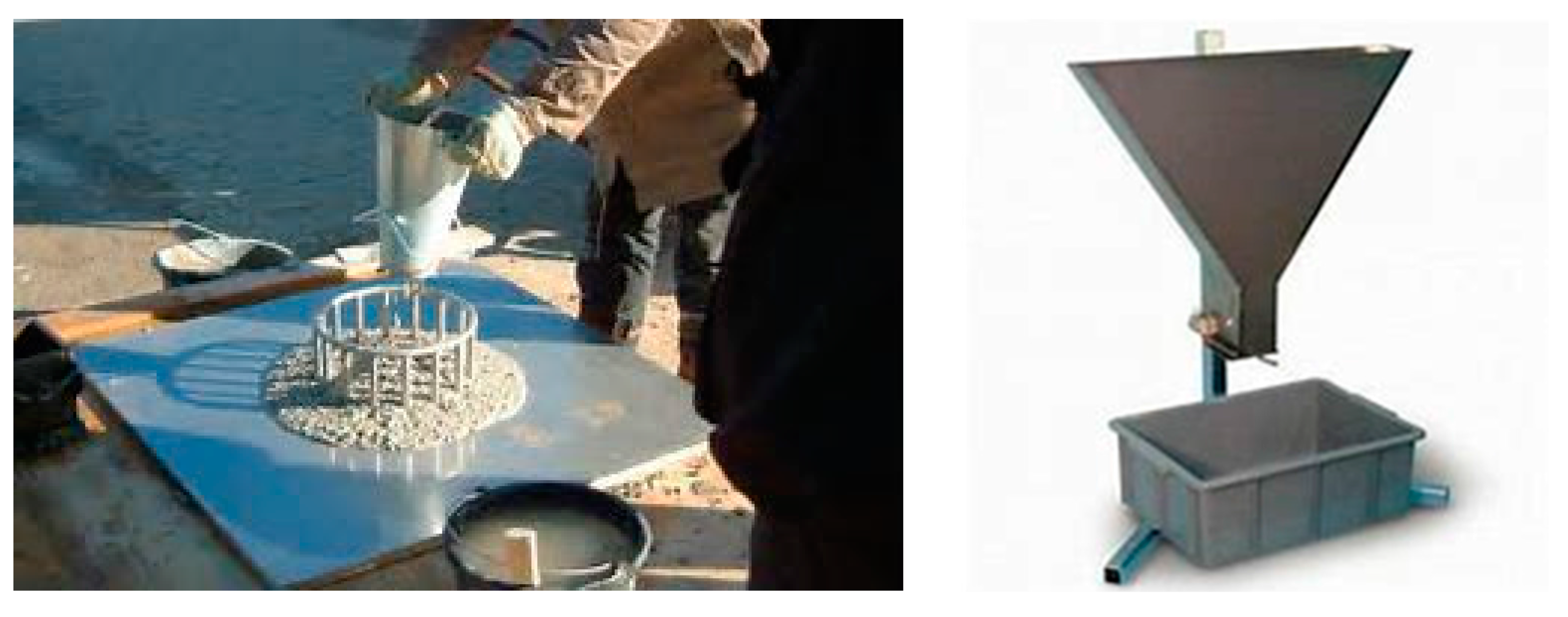

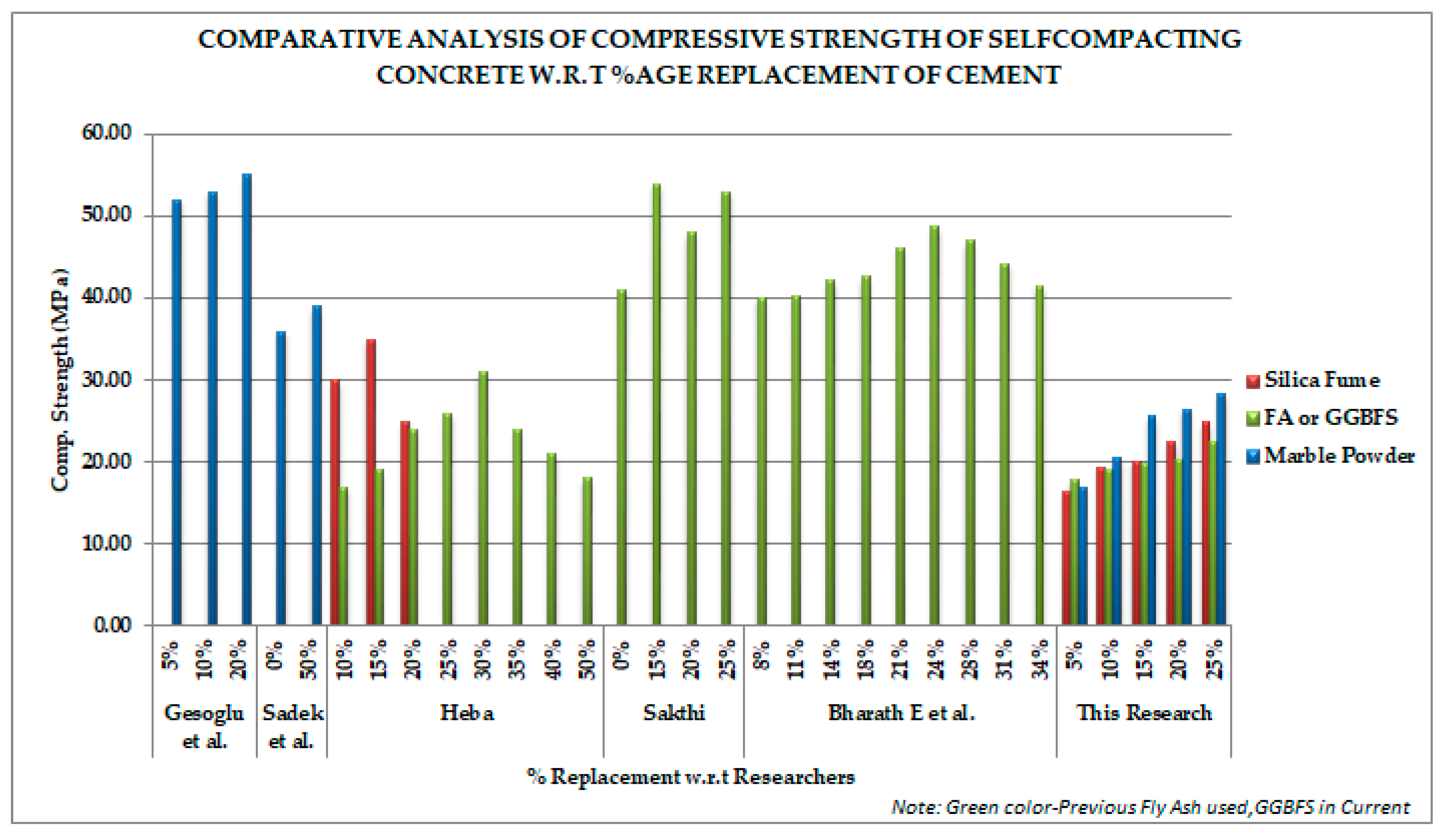
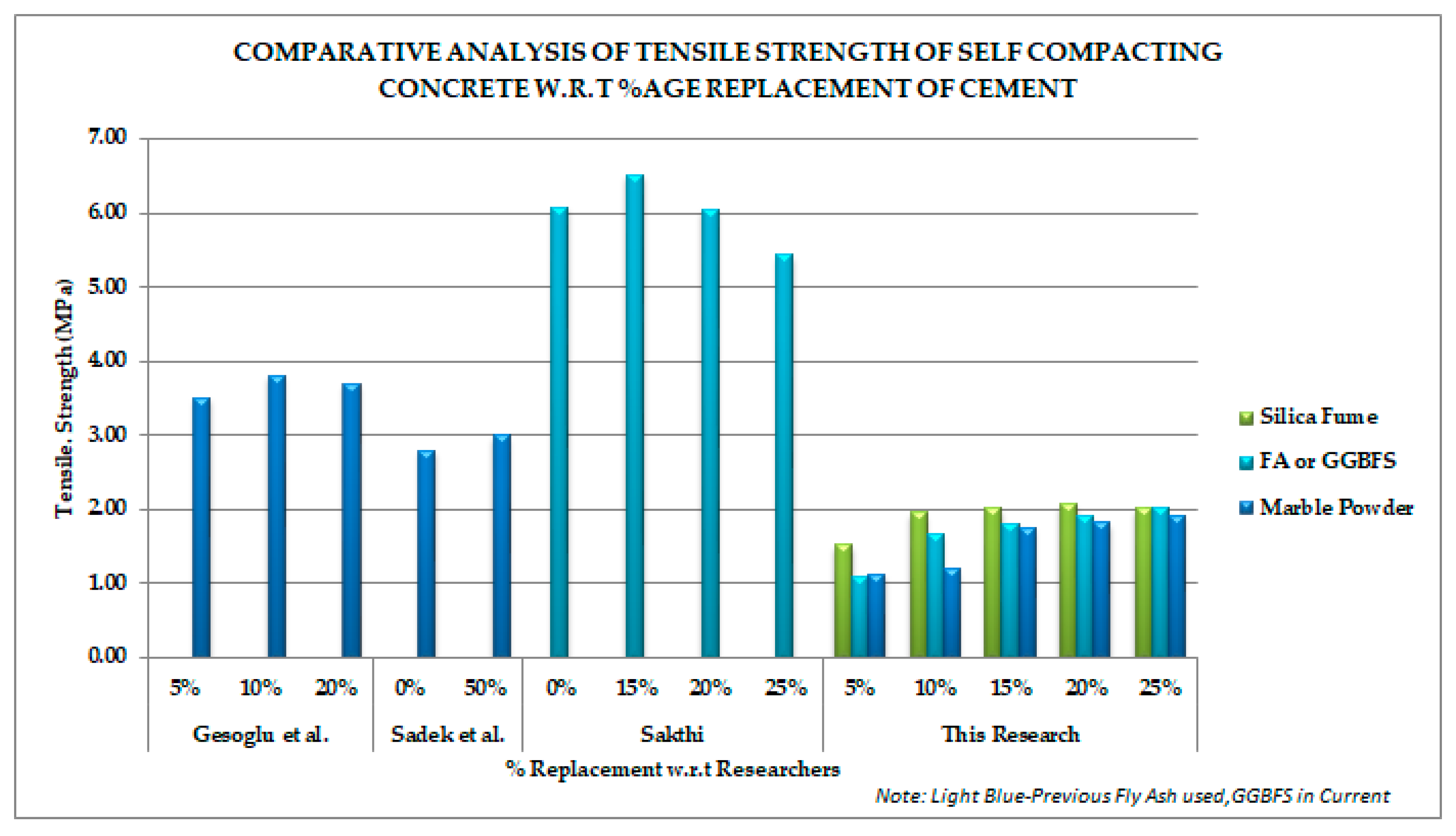
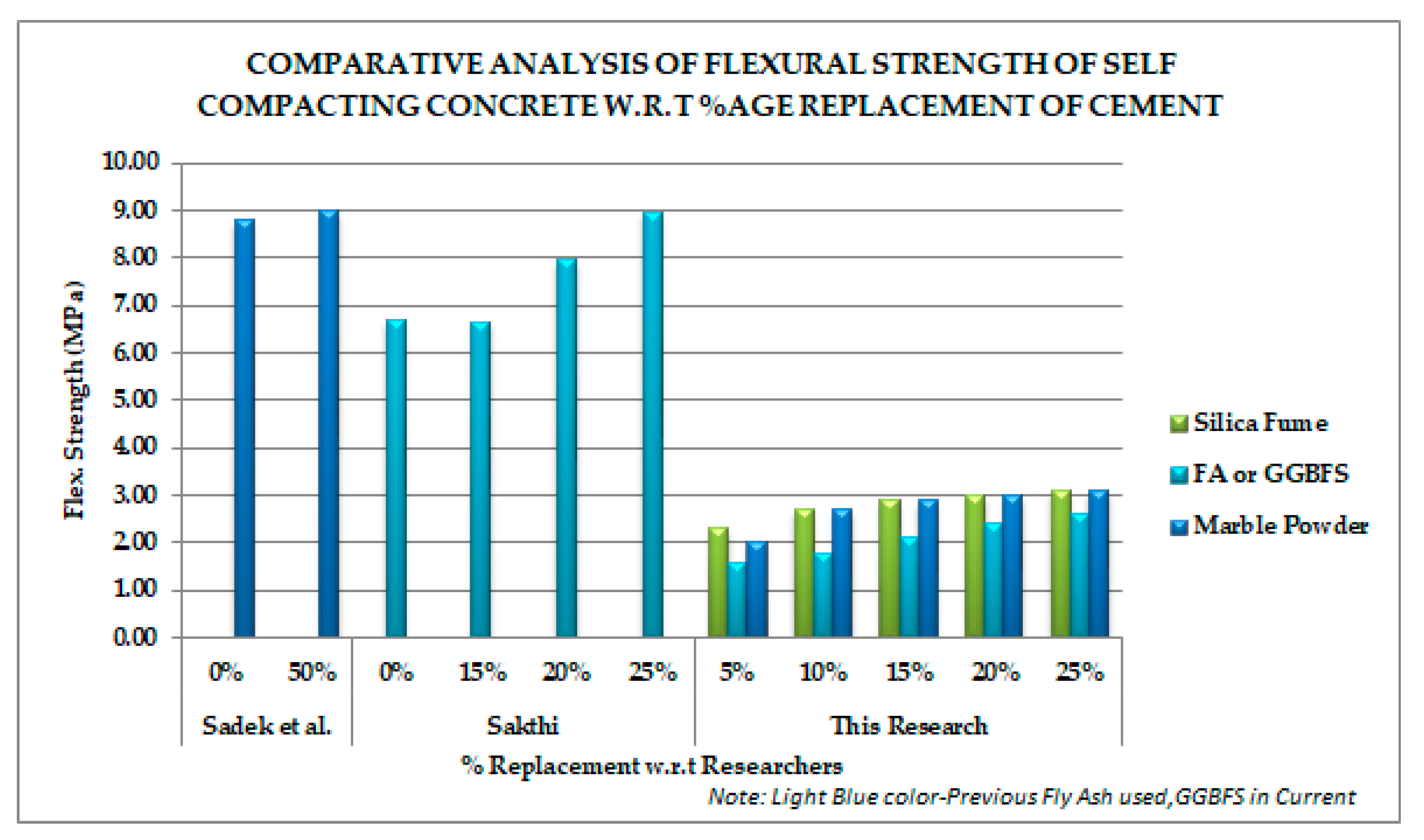
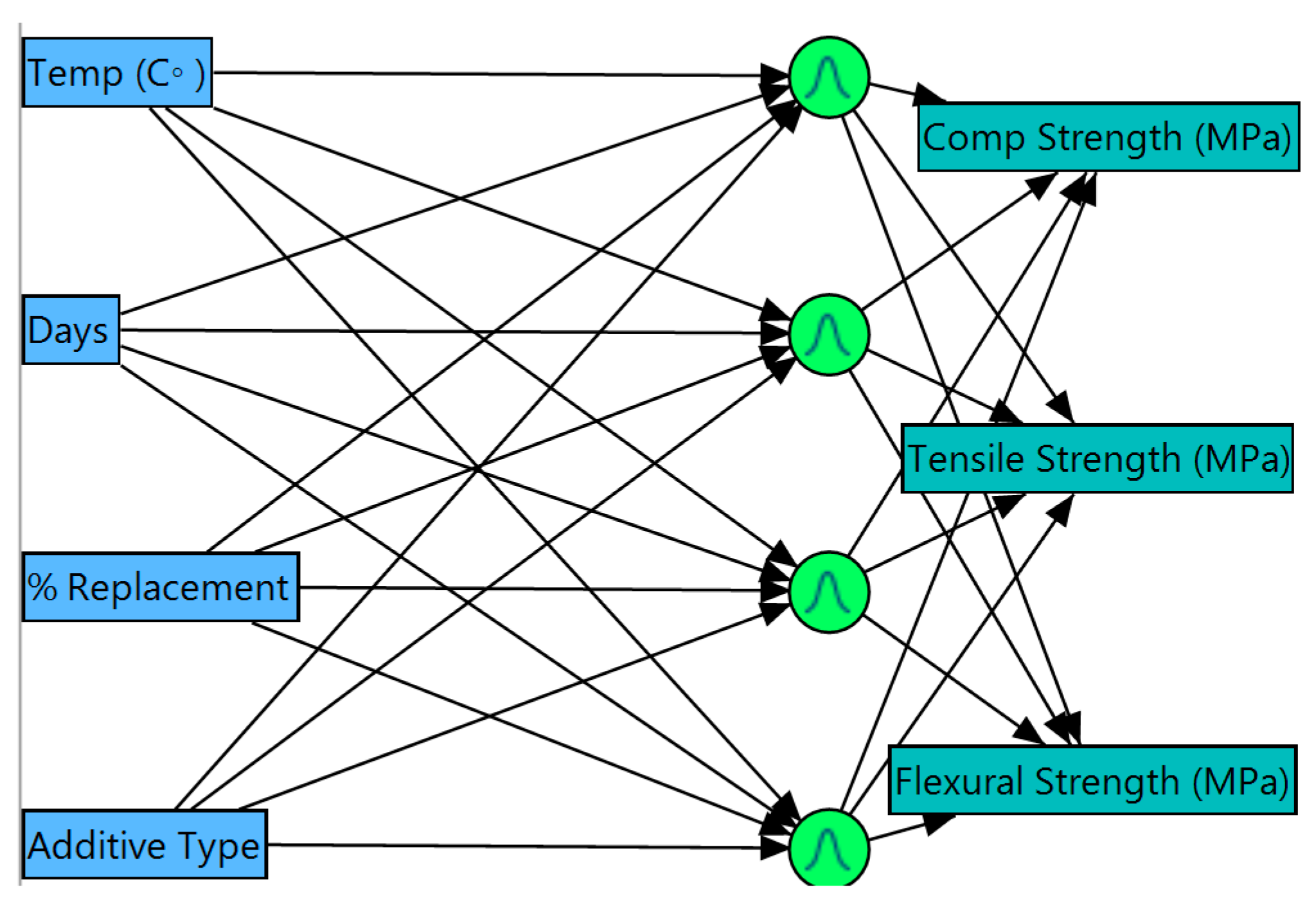
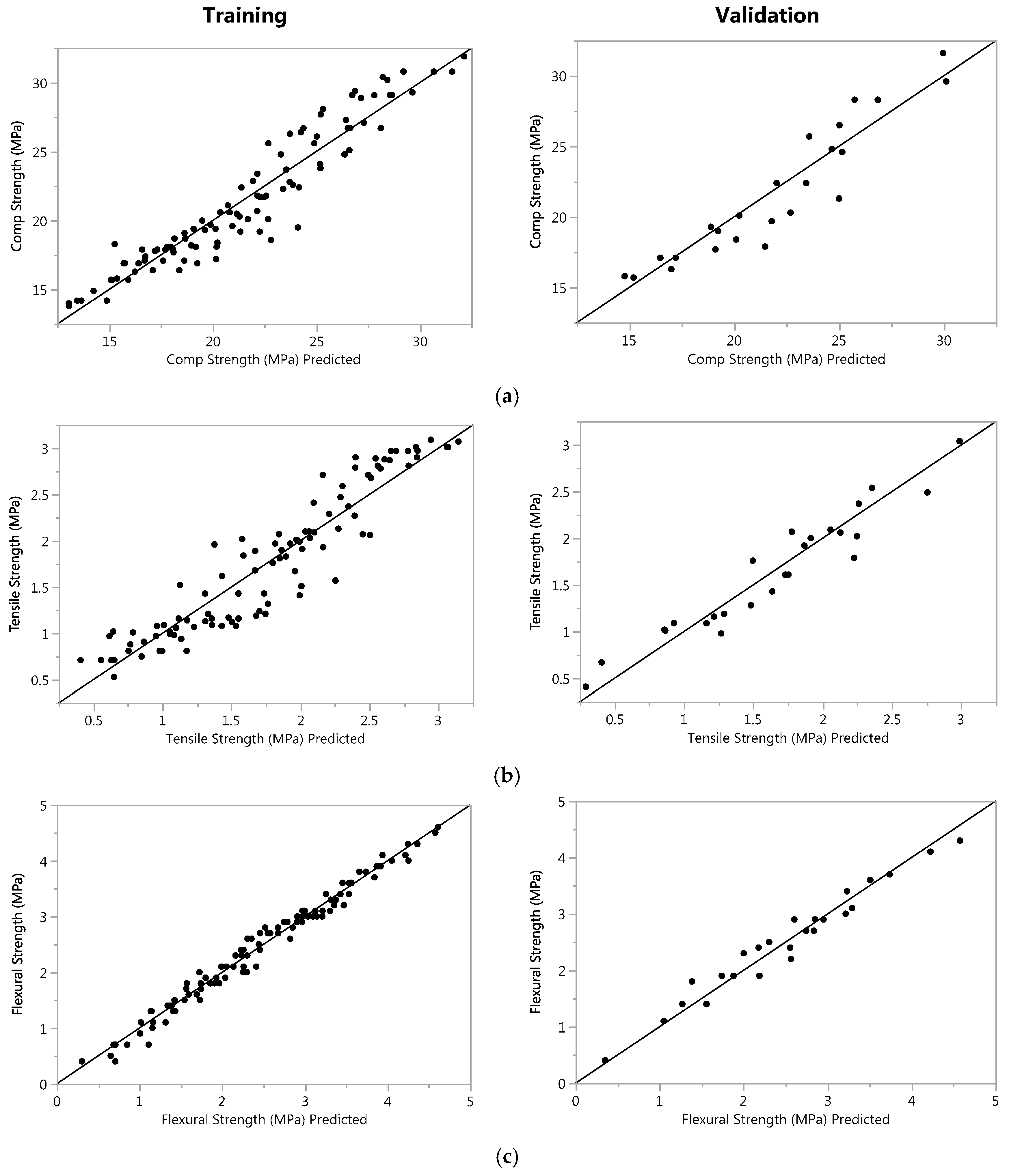
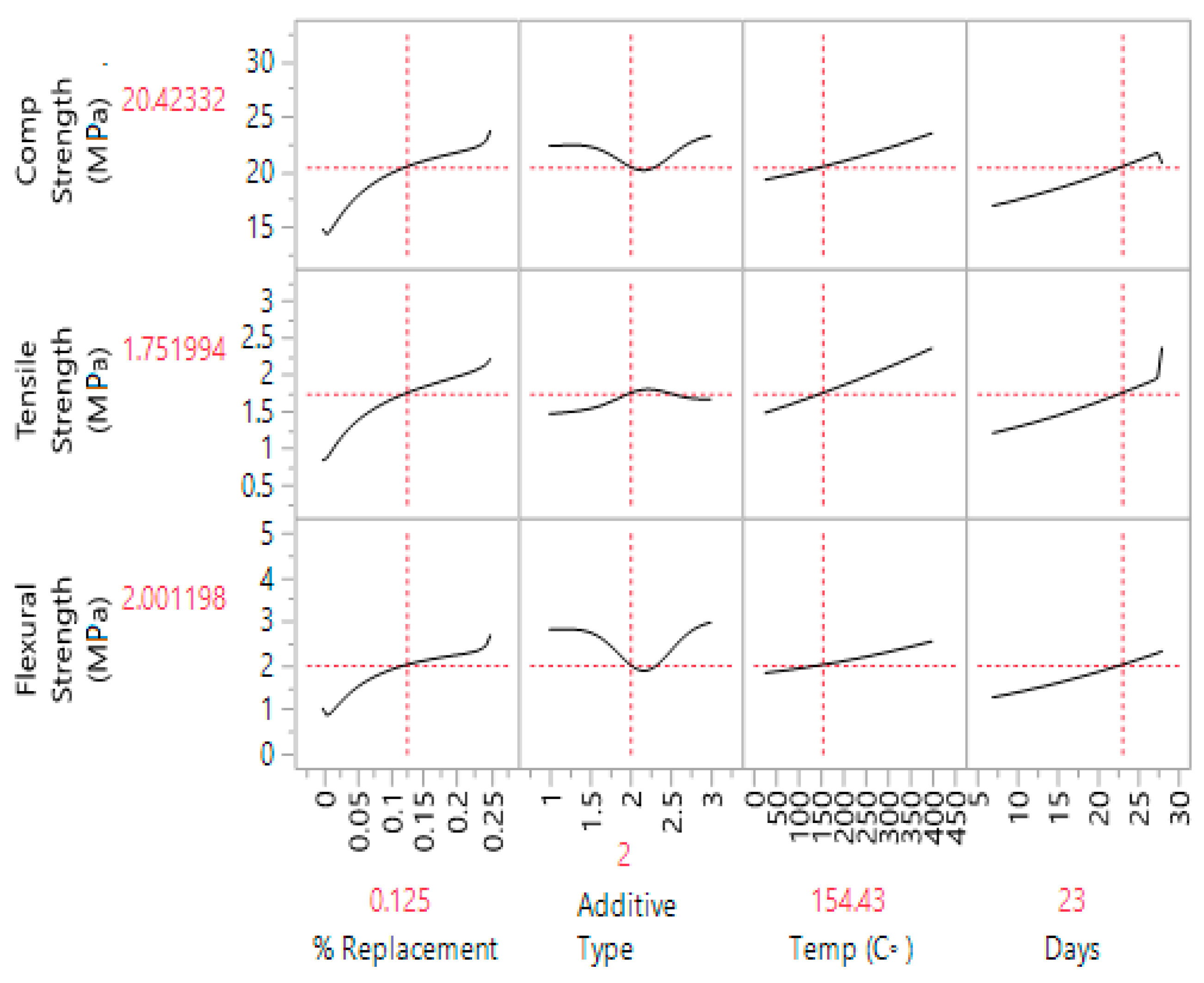
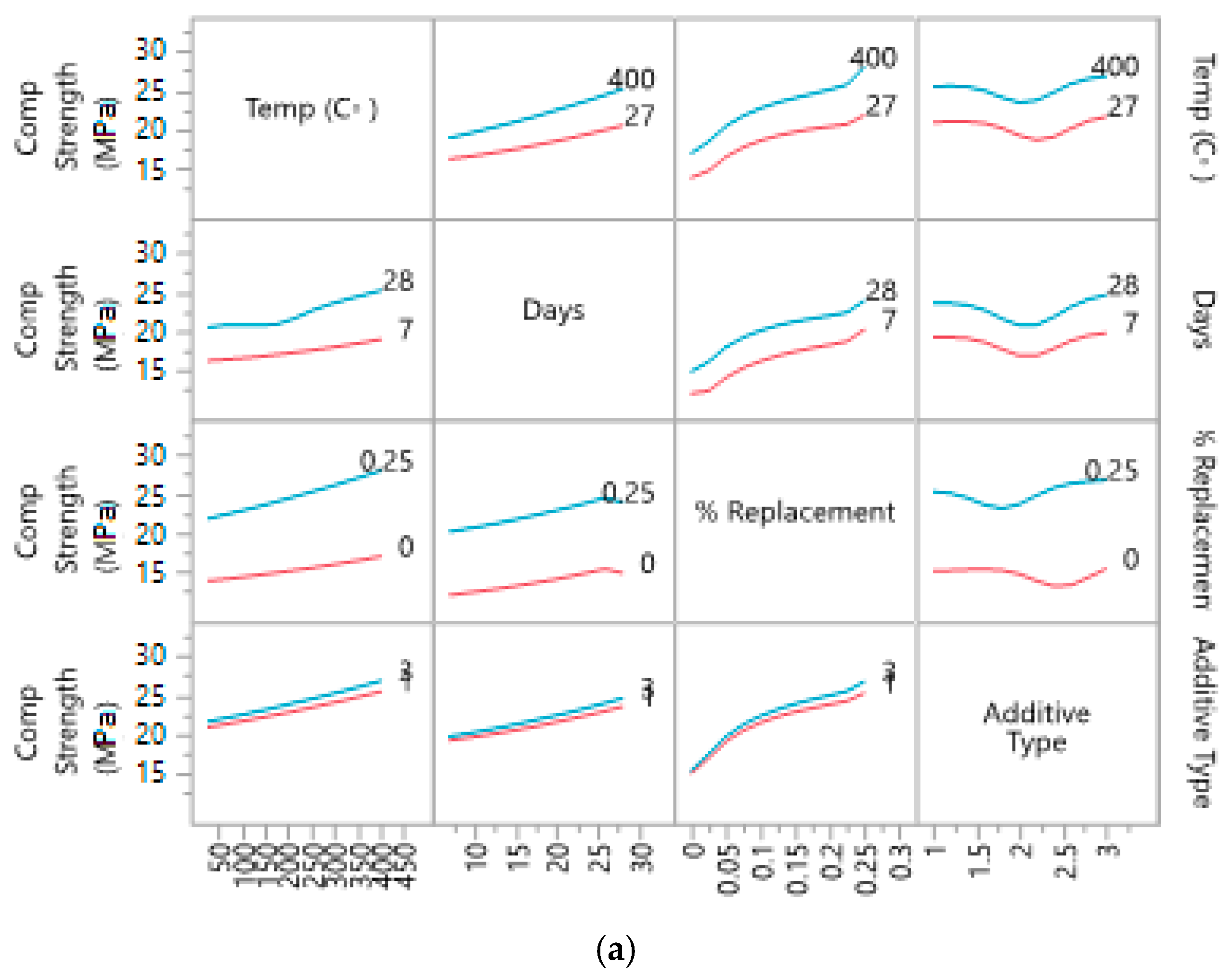

| Property | Materials | ||
|---|---|---|---|
| SF | GGBFS | MP | |
| Color | Light Blue | Dull Grey | White |
| Consistency | 106.0% | 35.88% | 32% |
| Specific Gravity | 2.14 | 2.78 | 3.15 |
| Mix ID | Cement kg/m3 | Silica Fume kg/m3 | GGBFS (Slag) kg/m3 | Marble Powder kg/m3 | Coarse Aggregate kg/m3 | Fine Aggregate kg/m3 | Water kg/m3 | Super Plasticizer kg/m3 |
|---|---|---|---|---|---|---|---|---|
| CSSC | 300 | - | - | - | 900 | 450 | 120 | 4.8 |
| SF5 | 285 | 15 | - | - | 900 | 450 | 120 | 4.8 |
| SF10 | 270 | 30 | - | - | 900 | 450 | 120 | 4.8 |
| SF15 | 255 | 45 | - | - | 900 | 450 | 120 | 4.8 |
| SF20 | 240 | 60 | - | - | 900 | 450 | 120 | 4.8 |
| SF25 | 225 | 75 | - | - | 900 | 450 | 120 | 4.8 |
| GGBFS5 | 285 | - | 15 | - | 900 | 450 | 120 | 4.8 |
| GGBFS10 | 270 | - | 30 | - | 900 | 450 | 120 | 4.8 |
| GGBFS15 | 255 | - | 45 | - | 900 | 450 | 120 | 4.8 |
| GGBFS20 | 240 | - | 60 | - | 900 | 450 | 120 | 4.8 |
| GGBFS25 | 225 | - | 75 | - | 900 | 450 | 120 | 4.8 |
| MP5 | 285 | - | - | 15 | 900 | 450 | 120 | 4.8 |
| MP10 | 270 | - | - | 30 | 900 | 450 | 120 | 4.8 |
| MP15 | 255 | - | - | 45 | 900 | 450 | 120 | 4.8 |
| MP20 | 240 | - | - | 60 | 900 | 450 | 120 | 4.8 |
| MP25 | 225 | - | - | 75 | 900 | 450 | 120 | 4.8 |
| Materials | Properties | ||
|---|---|---|---|
| Cement Replacement % Age | Slump Test | V-Funnel Test | J-Ring Test |
| Slump (mm) | Time (s) | Distance (mm) | |
| SF 5% | 684 | 10.0 | 32 |
| SF 10% | 700 | 9.7 | 34 |
| SF 15% | 710 | 9.5 | 35 |
| SF 20% | 702 | 9.6 | 33 |
| SF 25% | 690 | 9.9 | 31 |
| GGBFS 5% | 743 | 9.1 | 38 |
| GGBFS 10% | 759 | 9.0 | 41 |
| GGBFS 15% | 760 | 10.8 | 43 |
| GGBFS 20% | 751 | 11.0 | 39 |
| GGBFS 25% | 742 | 10.6 | 41 |
| MP 5% | 760 | 9.6 | 35 |
| MP 10% | 773 | 10.0 | 38 |
| MP 15% | 782 | 11.3 | 39 |
| MP 20% | 771 | 11.6 | 36 |
| MP 25% | 767 | 11.0 | 34 |
| Material Replaced | Silica Fume (S.F) | |||||||
| Days | Temp (°C) | 0% | 5% | 10% | 15% | 20% | 25% | |
| Compressive Strength (MPa) | 7 | 27 (R.T.) | 13.8 | 15.8 | 16.3 | 17.1 | 18.1 | 19.2 |
| 14 | 27 (R.T.) | 14.2 | 16.3 | 17.1 | 18.4 | 19.7 | 21.3 | |
| 28 | 27 (R.T.) | 15.7 | 16.4 | 19.4 | 20.1 | 22.4 | 24.8 | |
| 28 | 100 °C | 16.9 | 17.7 | 19.6 | 21.8 | 26.7 | 27.1 | |
| 28 | 200 °C | 17.1 | 18.1 | 20.7 | 22.6 | 28.3 | 29.1 | |
| 28 | 300 °C | 17.9 | 19.2 | 22.3 | 23.8 | 28.9 | 29.6 | |
| 28 | 400 °C | 18.2 | 21.7 | 24.8 | 26.7 | 29.1 | 30.8 | |
| Material Replaced | Ground Granulated Blast Furnace Slag (GGBFS) | |||||||
| Days | Temp (°C) | 0% | 5% | 10% | 15% | 20% | 25% | |
| 7 | 27 (R.T.) | 13.8 | 14.0 | 14.9 | 15.8 | 17.4 | 18.4 | |
| 14 | 27 (R.T.) | 14.2 | 18.3 | 17.9 | 18.1 | 19.0 | 20.3 | |
| 28 | 27 (R.T.) | 15.7 | 17.8 | 19.1 | 19.7 | 20.3 | 22.4 | |
| 28 | 100 °C | 16.9 | 18.1 | 20.0 | 20.6 | 21.7 | 24.6 | |
| 28 | 200 °C | 17.1 | 19.4 | 21.1 | 21.8 | 22.8 | 25.1 | |
| 28 | 300 °C | 17.9 | 20.1 | 22.4 | 23.7 | 24.1 | 26.7 | |
| 28 | 400 °C | 18.7 | 22.4 | 24.8 | 25.6 | 26.7 | 29.3 | |
| Material Replaced | Marble Powder (MP) | |||||||
| Days | Temp (°C) | 0% | 5% | 10% | 15% | 20% | 25% | |
| 7 | 27 (R.T.) | 13.8 | 15.7 | 17.3 | 17.7 | 19.31 | 20.1 | |
| 14 | 27 (R.T.) | 14.2 | 16.4 | 19.3 | 20.6 | 22.87 | 26.5 | |
| 28 | 27 (R.T.) | 15.7 | 16.9 | 20.5 | 25.6 | 26.4 | 28.3 | |
| 28 | 100 °C | 16.9 | 17.2 | 23.4 | 26.3 | 28.1 | 29.1 | |
| 28 | 200 °C | 17.1 | 17.9 | 25.7 | 27.7 | 29.4 | 30.8 | |
| 28 | 300 °C | 17.9 | 18.6 | 26.1 | 29.1 | 30.2 | 30.8 | |
| 28 | 400 °C | 18.7 | 19.5 | 27.3 | 30.4 | 31.6 | 31.9 | |
| Material Replaced | Silica Fume (S.F) | |||||||
| Days | Temp (°C) | 0% | 5% | 10% | 15% | 20% | 25% | |
| Tensile Strength (MPa) | 7 | 27 °C (R.T.) | 0.41 | 0.67 | 0.97 | 1.01 | 1.08 | 1.14 |
| 14 | 27 °C (R.T.) | 0.71 | 1.01 | 1.06 | 1.19 | 1.28 | 1.61 | |
| 28 | 27 °C (R.T.) | 1.02 | 1.52 | 1.96 | 2.02 | 2.07 | 2.01 | |
| 28 | 100 °C | 0.81 | 0.98 | 1.08 | 1.21 | 1.67 | 1.93 | |
| 28 | 200 °C | 1.09 | 1.17 | 1.32 | 1.41 | 1.79 | 2.07 | |
| 28 | 300 °C | 1.16 | 1.24 | 1.51 | 1.57 | 2.06 | 2.49 | |
| 28 | 400 °C | 1.43 | 1.97 | 2.02 | 2.68 | 2.97 | 3.01 | |
| Material Replaced | Ground Granulated Blast Furnace Slag (GGBFS) | |||||||
| Days | Temp (°C) | 0% | 5% | 10% | 15% | 20% | 25% | |
| 7 | 27 °C (R.T.) | 0.41 | 0.53 | 0.75 | 0.81 | 0.94 | 1.07 | |
| 14 | 27 °C (R.T.) | 0.71 | 0.98 | 1.13 | 1.17 | 1.43 | 1.61 | |
| 28 | 27 °C (R.T.) | 1.02 | 1.08 | 1.68 | 1.81 | 1.91 | 2.03 | |
| 28 | 100 °C | 0.81 | 1.84 | 2.07 | 2.10 | 2.29 | 2.37 | |
| 28 | 200 °C | 1.09 | 1.97 | 2.41 | 2.59 | 2.71 | 2.89 | |
| 28 | 300 °C | 1.16 | 2.09 | 2.54 | 2.78 | 2.81 | 2.90 | |
| 28 | 400 °C | 1.43 | 2.47 | 2.88 | 2.97 | 3.01 | 3.07 | |
| Material Replaced | Marble Powder (MP) | |||||||
| Days | Temp (°C) | 0% | 5% | 10% | 15% | 20% | 25% | |
| 7 | 27 °C (R.T.) | 0.41 | 0.71 | 0.88 | 0.91 | 0.97 | 1.09 | |
| 14 | 27 °C (R.T.) | 0.71 | 0.99 | 1.16 | 1.21 | 1.62 | 1.76 | |
| 28 | 27 °C (R.T.) | 1.02 | 1.12 | 1.19 | 1.76 | 1.83 | 1.92 | |
| 28 | 100 °C | 0.81 | 1.89 | 1.90 | 1.99 | 2.09 | 2.10 | |
| 28 | 200 °C | 1.09 | 2.00 | 2.06 | 2.13 | 2.27 | 2.37 | |
| 28 | 300 °C | 1.16 | 2.71 | 2.79 | 2.81 | 2.97 | 2.87 | |
| 28 | 400 °C | 1.43 | 2.90 | 2.97 | 3.01 | 3.04 | 3.09 | |
| Material Replaced | Silica Fume (S.F) | |||||||
| Days | Temp (°C) | 0% | 5% | 10% | 15% | 20% | 25% | |
| Flexural Strength (MPa) | 7 | 27 °C (R.T.) | 0.4 | 1.8 | 2.0 | 2.1 | 2.3 | 2.6 |
| 14 | 27 °C (R.T.) | 0.7 | 1.9 | 2.1 | 2.4 | 2.7 | 2.9 | |
| 28 | 27 °C (R.T.) | 1.1 | 2.3 | 2.7 | 2.9 | 3.0 | 3.1 | |
| 28 | 100 °C | 1.3 | 2.5 | 2.9 | 3.0 | 3.4 | 3.6 | |
| 28 | 200 °C | 1.4 | 2.8 | 3.1 | 3.3 | 3.7 | 3.9 | |
| 28 | 300 °C | 1.5 | 2.9 | 3.4 | 3.8 | 4.0 | 4.1 | |
| 28 | 400 °C | 1.8 | 3.1 | 3.6 | 4.1 | 4.3 | 4.5 | |
| Material Replaced | Ground Granulated Blast Furnace Slag (GGBFS) | |||||||
| Days | Temp (°C) | 0% | 5% | 10% | 15% | 20% | 25% | |
| 7 | 27 °C (R.T.) | 0.4 | 0.5 | 0.7 | 0.9 | 1.1 | 1.3 | |
| 14 | 27 °C (R.T.) | 0.7 | 1.0 | 1.4 | 1.7 | 1.9 | 2.3 | |
| 28 | 27 °C (R.T.) | 1.1 | 1.6 | 1.8 | 2.1 | 2.4 | 2.6 | |
| 28 | 100 °C | 1.3 | 1.7 | 1.9 | 2.4 | 2.7 | 2.9 | |
| 28 | 200 °C | 1.4 | 1.8 | 2.0 | 2.7 | 2.9 | 3.0 | |
| 28 | 300 °C | 1.5 | 1.9 | 2.2 | 2.8 | 3.1 | 3.2 | |
| 28 | 400 °C | 1.8 | 2.1 | 2.6 | 3.0 | 3.6 | 3.8 | |
| Material Replaced | Marble Powder (MP) | |||||||
| Days | Temp (°C) | 0% | 5% | 10% | 15% | 20% | 25% | |
| 7 | 27 °C (R.T.) | 0.4 | 1.4 | 1.6 | 1.9 | 2.1 | 2.3 | |
| 14 | 27 °C (R.T.) | 0.7 | 1.9 | 2.4 | 2.5 | 2.8 | 2.9 | |
| 28 | 27 °C (R.T.) | 1.1 | 2.0 | 2.7 | 2.9 | 3.0 | 3.1 | |
| 28 | 100 °C | 1.3 | 2.4 | 3.0 | 3.1 | 3.2 | 3.4 | |
| 28 | 200 °C | 1.4 | 2.7 | 3.4 | 3.6 | 3.7 | 3.9 | |
| 28 | 300 °C | 1.5 | 3.0 | 3.6 | 3.9 | 4.1 | 4.3 | |
| 28 | 400 °C | 1.8 | 3.3 | 3.9 | 4.0 | 4.3 | 4.6 | |
| Title | Description | Mean | Std Dev | Min | Max |
|---|---|---|---|---|---|
| Temp (°C) | Temperature at which concrete is treated | 154.42 | 139.55 | 27 | 400 |
| Days | Curing Days | 23 | 8.15 | 7 | 28 |
| % Replacement | % replacement of Cement | 0.12 | 0.08 | 0 | 0.25 |
| Additive Type | 1-SF,2-GGBFS,3-MP | 1 | 3 | ||
| Comp Strength | Compressive Strength(Mpa) | 21.36 | 4.84 | 13.8 | 31.9 |
| Tensile Strength | Tensile Strength (Mpa) | 1.70 | 0.74 | 0.41 | 3.09 |
| Flexural Strength | Flexural Strength (Mpa) | 2.49 | 1.01 | 0.4 | 4.6 |
| Measures | Training Value | Validation Value |
| Comp Strength (MPa) | ||
| R2 | 0.8964971 | 0.8840574 |
| RMSE | 1.5545618 | 1.6407749 |
| SSE | 244.0829 | 67.303554 |
| Sum Freq | 101 | 25 |
| Tensile Strength (MPa) | ||
| R2 | 0.9014651 | 0.887033 |
| RMSE | 0.2396624 | 0.2209019 |
| SSE | 5.8012436 | 1.2199412 |
| Sum Freq | 101 | 25 |
| Flexural Strength (MPa) | ||
| R2 | 0.9631447 | 0.9427365 |
| RMSE | 0.1993 | 0.2153234 |
| SSE | 4.0117714 | 1.1591039 |
| Sum Freq | 101 | 25 |
| Factors | Main Effect | Total Effect | Profile |
| Overall Variable Importance | |||
| % Replacement | 0.215 | 0.472 |  |
| Additive Type | 0.417 | 0.417 |  |
| Temp (°C) | 0.212 | 0.214 |  |
| Days | 0.156 | 0.167 |  |
| Comp Strength (MPa)-Variable Importance | |||
| % Replacement | 0.257 | 0.546 |  |
| Additive Type | 0.402 | 0.402 |  |
| Temp (°C) | 0.189 | 0.189 |  |
| Days | 0.152 | 0.152 |  |
| Tensile Strength (MPa)Variable Importance | |||
| Additive Type | 0.393 | 0.393 |  |
| % Replacement | 0.137 | 0.337 |  |
| Temp (°C) | 0.322 | 0.322 |  |
| Days | 0.147 | 0.181 |  |
| Flexural Strength (MPa)-Variable Importance | |||
| % Replacement | 0.25 | 0.532 |  |
| Additive Type | 0.456 | 0.456 |  |
| Days | 0.169 | 0.169 |  |
| Temp (°C) | 0.125 | 0.132 |  |
© 2018 by the authors. Licensee MDPI, Basel, Switzerland. This article is an open access article distributed under the terms and conditions of the Creative Commons Attribution (CC BY) license (http://creativecommons.org/licenses/by/4.0/).
Share and Cite
Mansoor, J.; Shah, S.A.R.; Khan, M.M.; Sadiq, A.N.; Anwar, M.K.; Siddiq, M.U.; Ahmad, H. Analysis of Mechanical Properties of Self Compacted Concrete by Partial Replacement of Cement with Industrial Wastes under Elevated Temperature. Appl. Sci. 2018, 8, 364. https://doi.org/10.3390/app8030364
Mansoor J, Shah SAR, Khan MM, Sadiq AN, Anwar MK, Siddiq MU, Ahmad H. Analysis of Mechanical Properties of Self Compacted Concrete by Partial Replacement of Cement with Industrial Wastes under Elevated Temperature. Applied Sciences. 2018; 8(3):364. https://doi.org/10.3390/app8030364
Chicago/Turabian StyleMansoor, Junaid, Syyed Adnan Raheel Shah, Mudasser Muneer Khan, Abdullah Naveed Sadiq, Muhammad Kashif Anwar, Muhammad Usman Siddiq, and Hassam Ahmad. 2018. "Analysis of Mechanical Properties of Self Compacted Concrete by Partial Replacement of Cement with Industrial Wastes under Elevated Temperature" Applied Sciences 8, no. 3: 364. https://doi.org/10.3390/app8030364



